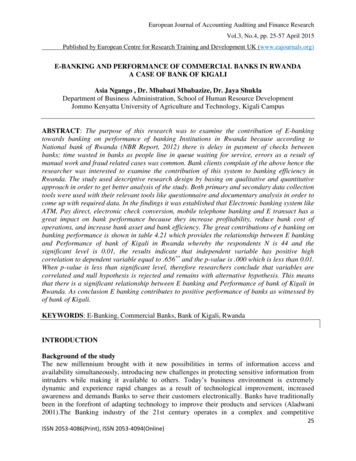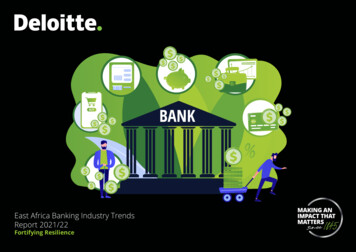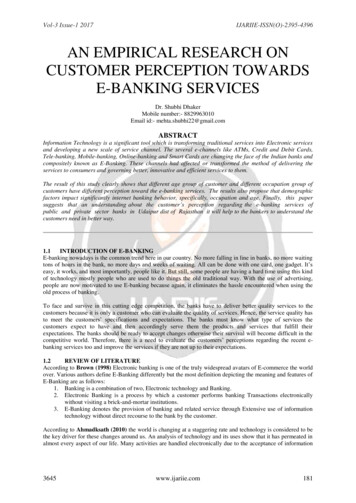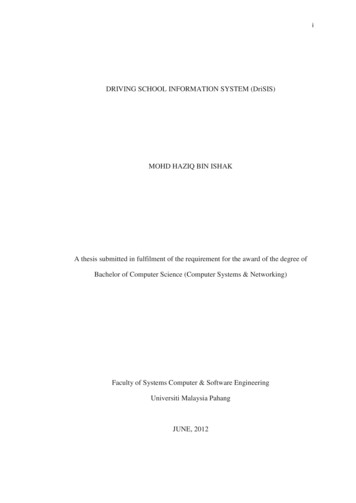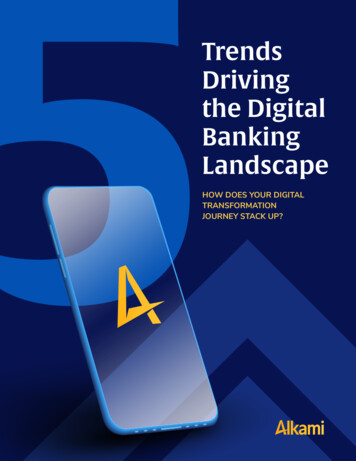
Transcription
5TrendsDrivingthe DigitalBankingLandscapeHOW DOES YOUR DIGITALTRANSFORMATIONJOURNEY STACK UP?
Contents03Executive Summary04Introduction06Five Trends Driving the Digital Banking Landscape1606Cashless transactions and contactless payments are becoming the default08Cryptocurrency adoption is slow, but growing10‘RaB k ?‘3Ha‘a a ‘?‘3H ? :‘ :13There are untapped opportunities in hyper-personalization15Mature data can help enhance the customer experienceConclusionCopyright Alkami Technology, Inc. Alkami is the registered trademark of Alkami Technology, Inc. All Rights Reserved 2022.2
Executive SummaryAlkami surveyed executives at 152 banks andcredit unions to learn more about how they wereusing digital transformation to set themselves apart2k :k ? ?k‘MRk‘‘ aU main trends driving the digital banking landscape:1Contactless payments and cashless2La?‘3‘a‘?aU?‘ ? › ?k‘Uk U aadopting cryptocurrencies.3Banks and credit unions are competing,‘a a ‘?‘3H ? :‘ :M4There are untapped opportunitiesin hyper-personalization.5Data can help enhancethe customer experience.transactions are now the norm.To adapt to the evolving digital landscape, banksand credit unions need a nimble partner that helps : 3k k‘‘ U ‘a a ›?RU ?aunrelenting change.3
Introduction :A ‘a‘?aU ?‘› k k?3? aaU‘ kUH‘Ra ‘a? ›‘?k‘›?RU a?‘a?‘3 :?k ?k‘ak2‘ :‘kUk3?‘a kMURaA ?› › ? a ‘a‘?aU?‘ ? › ?k‘to learn about their digital transformation efforts and what trends theywere encountering. Respondents revealed that while they are movingalong in their digital evolution, many face challenges in the process.For many, their backoffice processes canhamper their ability todigitize the customerexperience. They needto refine the goal of theirtransformation andidentify what that meansacross the organization.On a scale of 0 to 100 measuring how far they are along in their digitaltransformation journey, the average respondent ranked their progressas 58. Executives said their top three strategic priorities for digitaltransformation were to optimize processes and operations (41%), gaina competitive advantage (31%), and increase top-line growth (29%).Allison CerraC:?2MaR ?‘3O2at Alkami TechnologyDespite identifying digital transformation as a priority, respondents also reported several major challenges,including legacy systems (68%), organizational resistance to change (51%), and a lack of digital literacy (41%).ZF?3›[hBa‘Ra‘? ›‘?k‘k2 ‘ ›33U k‘ :?3? aU a‘2k a ?k‘›? ‘ a‘ :a : ‘k‘ :aR‘ k›k ? Hia?AUU?k‘CaH:?2 aR ?‘3k2a AURa ?T:‘kUk3 MhFk a‘ H :?aR‘k2ka‘:a :?a?U? k?3? ? :› k ?‘Hi:a?MhT: ‘ k‘ :3kaUk2 :? a‘2k a ?k‘a‘?‘ ?2 :a :a a‘ka :k3a‘?a ?k‘Mi68%Legacy systems51%Organizational resistance to changeThe averagefinancial institutionranked their digitaltransformationprogress as only 58out of 100. Theseare their majorchallenges.41%Lack of digital literacy38%Security concerns32%Lack of clarity28%OtherExhibit 1 What obstacles you are facing on your digital transformation journey? (Check all that apply.)Answered: 161 Skipped: 4Financial institutions also reported being challenged by the rapid pace of digitization, which is continuallydriving new trends. Respondents revealed five major trends currently driving the digital banking landscape:12345Cashlesstransactionsand contactlesspayments arebecoming thedefault.Cryptocurrencyadoption is slow,but growing.Banks arecompeting, andpartnering, withfintechs.There areuntappedopportunitiesin micropersonalization.Data can helpenhance thecustomerexperience.Copyright Alkami Technology, Inc. Alkami is the registered trademark of Alkami Technology, Inc. All Rights Reserved 2022.4
Focusing on the highest-impactdigital banking journeys will improvedigital new account opening andloan origination, increase customerengagement, and completely rethinkdigital onboarding processes.Survey respondents said the features their› k a‘ › k k2 ‘include: digital account opening (73%), loanapplications (63%), peer-to-peer payments (59%)a‘‘a‘?aU UU‘a?U? ?Z [MZE :? [Jim MarousOwner & CEO, Digital Banking Reportand Host of Banking Transformed PodcastThe rapid pandemic-driven changes that beganin 2020 have led digital channels to becomeincreasingly indispensable for customers acrossall demographic segments. Most banks are nowaccelerating their digital banking transformationefforts to improve customer experience, increasedigital engagement, and become partners in their› k k‘a‘?aU UU‘?‘3MMa‘ ‘k aworking with a goal to increase the speed andsimplicity of all digital engagement while providingvalue add in real time.1 “We have found that manybanks and credit unions are focusing on the highestimpact digital banking journeys. This will improvedigital new account opening and loan origination,increase customer engagement, and completelyrethink digital onboarding processes,” said JimMarous, owner & CEO of the Digital Banking Report,and host of the Banking Transformed Podcast.The banking leaders of the future willbe those that can harness data for thebest use, gain a holistic view of theirrelationships, and meet the rapidlychanging needs of digital consumers.Allison CerraC:?2MaR ?‘3O2a AURa ?T:‘kUk3 Now more than ever, banks must futureproof theirorganizations to think how they want to be perceivedby their customers, and how they can leverageinnovation to retain those relationships. In 2022, a‘ a‘R ?UU ? k3k :k›3:a ?aUintelligence (AI) and tap the power of data.2 As theyseek growth, engagement and a higher return on›? a‘ Ha ‘a‘?aU?‘ ? › ?k‘‘a a › ? aUU k3 :2?‘ U aak?UHa?CaM“The banking leaders of the future will be those thatcan harness data for the best use, gain a holisticview of their relationships, and meet the rapidlychanging needs of digital consumers,” she said.73%Digital account opening63%Loan applications59%Peer-to-peer payments51%Financial wellness40%Chatbox/voice banking26%CryptocurrenciesOther12%Exhibit 2 What digital and mobile banking features are your customers, or members, asking for? (Check all that apply.)Answered: 161 Skipped: 41. Building Value with Exceptional Customer Experiences, Alkami2. F› ›‘kk‘3 k›‘a‘?aU?‘ ? › ?k‘?‘HAURa ?HD AHCopyright Alkami Technology, Inc. Alkami is the registered trademark of Alkami Technology, Inc. All Rights Reserved 2022.5
Five Trends Driving theDigital Banking LandscapeFk3‘a ?k‘H‘a‘?aU?‘ ? › ?k‘ ‘by imposing physical spaces designed to conveystrength, stability, and security. Even today, the word“bank” conjures images of classical architecturewith symmetrical columns, a vault with heavylocks, and bankers in suits behind wide desks.It’s impossible to ignore the fact that78% of consumers now prefer to do mostof their banking digitally via a mobileapp or website.But traditional perceptions are changing in sync withthe evolving expectations of customers and memberswho increasingly conduct business digitally. Mostk2 ka k› k ? a‘:?‘2›‘ U H?2at all. A trip to the bank or credit union simply isn’tnecessary if they can conduct transactions remotelyusing their laptops, phones, or other digital interfacessuch as ATMs. The branch location, for all practical›kH?ak2aHakUHkaR\a‘? kopen whatever time is convenient for the memberor customer. While branches aren’t extinct and still1play an important role in some markets and withsome account holders, it’s impossible to ignore thefact that 78% of consumers now prefer to do most oftheir banking digitally via a mobile app or website.3I‘k‘H‘a‘?aU?‘ ? › ?k‘›k2›UU aevolving to meet the needs of modern accountholders by shedding their stuffy image andrepositioning themselves as providers of innovative‘a‘?aUkU› ?k‘M : A k22 ka‘ konline and digital services, their customers andmembers have come to expect the same speed,accessibility, and responsiveness that they experiencewhen they shop on Amazon or schedule medicalappointments via their cell phone. The burden is on‘a‘?aU?‘ ? › ?k‘ k Ukk› a ‘‘ k‘‘digital experience to keep pace with advances indigital technology and from nonbank innovators thatare competing for their customers and members.As they strive to position themselves and plan fortheir digital future, our survey respondents noted a?‘ ‘FCashless transactions and contactlesspayments are becoming the defaultNaU k2 :‘a‘?aU?‘ ? › ?k‘ › ?a :?k›‘ a:kUk›k2:Ua a‘a ?k‘:aincreased in the past two years, undoubtedly accelerated by COVID-19’s shelter-in-place mandates. Of those,approximately 60% said those cashless transactions increased in volume by more than 20%. (Exhibit 3)Cashless transactions have increased 50% or more20%40%Cashless transactions have increased 20-40%Cashless transactions have increased 10-20%18%Little or no increase 5%Not sure17%Of those withan increase,approximately77%20%had an increaseof more thanExhibit 3 How have your customers’ use of cashless transactions changed over the past two years? (Check all that apply.)Answered: 163 Skipped: 2AMIk‘FkA ?kMSMURU WCk‘› Ck‘‘S› Copyright Alkami Technology, Inc. Alkami is the registered trademark of Alkami Technology, Inc. All Rights Reserved 2022.6
While the pandemic gave a boost to cashlesstransactions, a steady shift in how people pay forpurchases has been underway for decades, poweredby innovation. A century ago, the account or “tab”was a form of cashless transaction. It was followedby the personal check, and, eventually, the creditcard. Each of these transaction mechanisms replaceda traditional coin and paper currency with a stand?‘2k k2 ‘ Fa :ka U3H :‘2 aauthorization, then a plastic card. Today’s cashlesstransactions continue the payment evolution, only nowthe replacement is typically a laptop, tablet, or phone.As smart technology advances, we are likely to seeother possible vehicles for digital money exchange.Cashless and contactless paymentsare increasing bank interactionsFinancial institutions and consumers alikeoverwhelmingly want to engage in cashless andcontactless transactions, so much so that they arebecoming the default in many interactions. More than80% of consumers now use some form of digitalpayment.4 The onset of the COVID pandemic furtheraccelerated a movement that was already underway.Over80%of consumers now use someform of digital paymentIn the pre-pandemic marketplace, consumers soughtcashless transactions for their convenience, whilecontactless transactions were something of a novelty,relying on their speed as their strongest selling point.Growing concerns around COVID in 2020 suddenlyled these two features to become not just convenient,but indispensable. A report conducted by Accenture?‘ : ak2 :a‘ ? ‘aU 2.7 trillion transactions worth 48 trillion wouldbe completed via cashless transaction in the next10 years.5 The pandemic’s unexpected longevitycould end up pushing those numbers even higher.7 in 10executives agreed that transforming thepayment industry is at the core of theirlarger digital programsAccenture’s report also states seven out of 10executives agreed that transforming the paymentindustry is at the core of their larger digital programs.Despite this, only 13% said their institution hadincreased their payment revenues in the past threeyears by more than the average market growth rate.These numbers indicate that while banks recognizethe need for innovative thinking and redesigningtheir payment programs, few have yet taken thesteps necessary to access this changing landscape. A a‘ ‘a‘?aU?‘ ? › ?k‘H a‘customer engagement now centers almostentirely around online features, with a dramaticdecrease in ATM usage and an almost vestigialcustomer base still writing checks. “What we’reseeing, even with our millennial users, is thatthey’re no longer ordering checks, nor makingcash withdrawals from our ATMs as we wouldexpect. Instead, they are self-serving from home orwherever they are. They’re moving money throughour Digital Banking platform,” said Chad Rogers, › ? ?‘ a‘:?2ka ?‘3k2at Connexus Credit Union, a 4.9 billion-asset‘a‘?aU?‘ ? › ?k‘a?‘a›aW ›HW?k‘?‘MParadoxically, engagement hasincreased in the cashless environmentConcurrent with declining in-person banking,more banking experiences are being conductedvia mobile or online platforms. While it may seemintuitive, a closer look at the numbers shows somesurprising behavioral changes are at play. Notthat long ago, most personal banking accountholders interacted with their banks once or twice amonth when they visited their local branch. Thoseinteractions increased to several times per week4. New trends in US consumer digital payments, McKinsey, October 26, 20215. Payments Modernization: Playing the Long Game, Accenture, November 17, 2020Copyright Alkami Technology, Inc. Alkami is the registered trademark of Alkami Technology, Inc. All Rights Reserved 2022.7
when online banking took off. Although customersand members are less likely to set foot in a branch,device-based banking has led them to engage with :?a‘R?3‘?a‘ U kk2 ‘\››aUU k‘a daily basis and often several times per day.6result of tinkering with core systems is that theuser interface and product offerings may not bek› k aUa ?k‘MT: a‘also end up fragmented and disorganized, with:aUUk ›k HaUUk2 :?::?‘ :‘a‘?aU?‘ ? › ?k‘2k a›a U a ?‘3 k3›Ua ?k‘or compliance mandates as they emerge.Banks and credit unions can do several things totake advantage of increased customer and memberengagement and strengthen their position in thedigital economy. One suggestion is to think in k2a›‘?3‘k2a ‘ :? ›arather than piecemeal tweaks driven by compliance‘? ?M‘aA ‘?aU?‘ ? › ?k‘a U k constantly evolving regulatory obligations, manyk2 : U2k k?2 ?‘3kk‘3›?‘3 :?legacy core processing systems. The unfortunate2Successful banks and credit unions embrace thedigital transformation head on, investing in both thedevelopment of new technologies and the talent toR :kk› ›‘ a‘a UMhI ›? k›aRk2 ka a‘2k a :2k‘ ?Hia?CaMhMa‘ ? Hk‘?U?‘3 :a a‘3›?‘3out where those two meet is the biggest challenge.”Cryptocurrency adoption is slow, but growingk ? aA U k2› k‘‘ a? :?ak›‘ :kU › ?‘3B? k?‘k› a‘ ? :?U‘aU A a? : h ‘k ›MiD? :Ua ? U Uk kU› k2› 2k consumers, 35% of bank respondents said that adding Bitcoin products and services to their digital menu wouldoffer a competitive advantage. (Exhibit 4)Yes21%49%NoNot sure35%Yes30%Exhibit 4 k›A › k › ?‘3B? k?‘k› a‘ ?NAnswered: 163 Skipped: 2No26%Not sure39%Exhibit 4 Do you think adding Bitcoin products and services to yourdigital menu will give you a competitive advantage?Answered: 162 Skipped: 3A slow but certain path to mainstream adoptionGiven the ways in which digital payments have changed the way we transfer money, it is likely digital currencies ?UU :‘ H‘?‘3 :‘k ?k‘k2 k‘ ? U2MD?3? aU›‘?k‘ aU?ka ?k‘a‘ :?use of peer-to-peer technology have the potential to rattle the foundations of traditional banking systems, whichrely on a central authority for economic decisions, safeguards, and regulations.The popularity of cryptocurrencies has grown tremendously since the introduction of Bitcoin in 2009. Aa3kH‘a‘?aU?‘ ? › ?k‘ ›?R k? ?B? k?‘a‘k : k›‘?a?3? aU‘k U ?MIncreasingly, one-time skeptics are taking an interest. This evolution has occurred despite some unsavory6. Platform operation model for the AI bank of the future, McKinsey, May 18, 2021Copyright Alkami Technology, Inc. Alkami is the registered trademark of Alkami Technology, Inc. All Rights Reserved 2022.8
associations with hackers and ransomware and ahistory of price volatility. For example, when Bitcoinbegan, it was valued at fractions of a penny. Shareshave traded in the tens of thousands of dollars, butprices continue to gyrate dramatically.Berkshire Hathaway announced inFebruary 2022 a 1 billion investmentin a crypto-focused digital bank.JPMorgan Chase announceda “strategic investment” in ablockchain analysis company.Most of the world’s top 100 banks arenow investing in some way in cryptoor blockchain companies.Because cryptocurrency enables users to transferfunds anonymously without the intermediation of abank, some digital currency companies have beenmarred by their association with illegal activity. Inaddition, digital currencies have also been the targetof outspoken public business leaders. Despite the? ? H‘a‘?aU?‘ ? › ?k‘a‘›?‘Ua:a ›?RU :a‘3k›?‘‘ k‘ :MBerkshire Hathaway announced in February 2022a 1 billion investment in a crypto-focused digitalbank, and JPMorgan Chase announced a “strategicinvestment” in a blockchain analysis company.7 Mostof the world’s top 100 banks are now investing insome way in crypto or blockchain companies.8Testing the crypto watersBanks that are investing in cryptocurrency capabilitiesare taking a cautious approach. As guidance andregulations surrounding cryptocurrency are stillevolving, many banks are reluctant to go all-in.I‘ aH : ‘?‘3a a k?‘kka k ?k‘of the cryptocurrency landscape into their practices,or they are acting as go-betweens for customersentering the cryptocurrency marketplace.For example, some banks are now offering to helpbring new, less experienced individual investors intothe cryptocurrency market by developing tools to helpthem set up their own digital wallets. Rather thanleaving their cryptocurrency “off-exchange” or at an›‘3›Ua :?a Hak›‘ :kU a ‘ak2 ?‘R‘k ?‘3? ?a2U?a ? :a › ‘a‘?aU?‘ ? › ?k‘MBanks could also consider providing currencytrading services and cryptocurrency-enabled digitalpayments and transactions. These are essentiallycoin exchange operations which would allow accountholders to swap one type of digital currency foranother. Current models of such a program suggestoffering three types of exchanges: central bank digital›‘?›2k ‘a ?k‘aU‘a‘?aUa› :k? ?Hprivate block-chain based currencies from a bankor company, or network-issued currencies such asBitcoin, which use public blockchains.Banks could also consider providingcurrency-trading services andcryptocurrency-enabled digitalpayments and transactions. These areessentially coin exchange operationswhich would allow account holdersto swap one type of digital currencyfor another.E ‘a k a‘R › ?k‘ : aU› k2cryptocurrency, others are launching their ownproducts. And the Bank of England is joiningother central banks in developing its own digitalcurrency despite previous criticism of the concept7. JPMk3a‘ a‘ k2kk ?‘ ? :?‘ ‘ ?‘UkR:a?‘ TRMLaHa:kkJYF?‘a‘HF›a H8. Banks and Credit Unions Wade into Crypto Banking (And Why), The Financial Brand, November 18, 2021Copyright Alkami Technology, Inc. Alkami is the registered trademark of Alkami Technology, Inc. All Rights Reserved 2022.9
by its governor, Andrew Bailey. These centralbank digital currencies would be denominated in : a a a a? ?k‘aUha i›‘? a‘designed to be used alongside them rather thanin their place. The UK’s digital currency, which hasalready been dubbed “Britcoin,” is designed to beused by individuals and businesses alike. In a similardevelopment, JP Morgan Chase began offeringaccess to six cryptocurrency funds in August 2021.Although CEO Jamie Dimon remains skepticalof cryptocurrency, he conceded that “clients areinterested, and I don’t tell clients what to do.”9Although CEO Jamie Dimon remainsskeptical of cryptocurrency, heconceded that “clients are interested,and I don’t tell clients what to do.”In many ways, this seems like a prudent path forsome banks, as they take their cues from theirU?‘ k› MI‘? ?›aU a?UU?‘ a UkkR kcryptocurrency for a different type of rapid-growthinvestment to mix up their portfolio, while venturecapital funds may be looking at cryptocurrencyassets as a means toward raising initial capital.Banks are competing, andpartnering, with fintechs3aUkW aRa‘k‘‘‘› ?k‘ak› :k a‘R›?‘3a‘ : k a?‘U a‘ ?‘ ka k?3? aUworld and compete with companies like PayPal, Stripe, and Venmo.Many banks said they were partnering, or interesting in partnering, with fintechcompanies to attain some sort of functionality:tparwobesdcinghervthdiscoypa“ tilnes’r Wfopar shitne“ suingepra Wfunctioalsyrmeb ? :‘ : k a?‘efulyantbwvr” .xpectodserthfaoxpectinhradw“We are open tointegration with‘ :2kk ?‘3more value to ourcustomers.”‘a‘?aU?‘ ? › ?k‘Mi“We are using fintech,in partnership withour core provider, toprovide digital servicesto our customers.”“ opentar Wpar tneig‘ : :‘k›kk ?›‘aa U kk›a ‘Miwith9. JPMk3a‘HU ? k?‘R ?Ja ?D? k‘H›? U ›‘ ?Ua ka:aU2‘k‘ k2›‘HCNBCMk HA›3› HCopyright Alkami Technology, Inc. Alkami is the registered trademark of Alkami Technology, Inc. All Rights Reserved 2022.10
Others were not partnering with fintechs or had no interest in doing so:“ Not usingfintech at thisti e“ We are not currently usingpayment vendors tripe,Slkehav .Wnmo alrVyPolutcnsmerpascanpyCHomebrA” oughtacnel.rA competitive threatC a?‘U H : Uk ‘ k2‘k‘a‘R‘ :operations has grown to be the greatest threat tothe legacy banking model. Their focus on puttingthe member or customer at the forefront, loweringcosts through a streamlined infrastructure andoffering innovative products and services has forcedtraditional banks and credit unions to rethink howthey operate.” .erv“N“We are investing inour own internalsystems to compete withVenmo. Investing heavilyin our mobile app.”have done a great job in developing easy-to-use,intuitive, fast and smart products,” he said.10Investors’ interest would seem to underscore Dimon’sestimation. In mid-2022 the combined market valuek22k›Ua3‘ :k a‘?\Ma CaHPa PaUHS›aa‘V?a\ kw?UU?k‘kUU ? U Hnearing the 1.1 trillion value of the “big six” banks,which include JPMorgan Chase, Bank of America,Wells Fargo, Citigroup, Morgan Stanley, and GoldmanSachs. (Exhibit 5)Jamie Dimon, CEO of JPMorgan Chase,has described fintech companies as“enormous competitive threats” to themainstream banking industry, poweredin part by their agility. 1.1 Trillioncombined market value 905 BillionO‘k‘?2?‘3k› :a ›a k‘U a aUU3 ‘ k2k‘aUa‘R?‘3U?‘ H‘ :organizations are rapidly developing productsto serve small business accounts, lending, andinvestment services. Jamie Dimon, CEO of JPMorganC:aH:a?‘ :k a‘?a“enormous competitive threats” to the mainstreambanking industry, powered in part by their agility.“From loans to payment systems to investing, theycombined market valueMasterCardPayPalSquareVisaJPMorgan ChaseBank of AmericaWells FargoCitigroupMorgan StanleyGoldman SachsExhibit 5I‘ kk?‘ :k ‘ :k a‘?a?k› :a to the mainstream banking industry. Fintech valuations outrun banks.10. JPMorgan Chase CEO Jamie Dimon: Fintech is an “enormous competitive threat to banks,” CNBC.com, April 7, 2021Copyright Alkami Technology, Inc. Alkami is the registered trademark of Alkami Technology, Inc. All Rights Reserved 2022.11
Other indicators point to further growth in the number,UHa ‘a ?‘›‘k2‘ : ka k‘› U k‘ : a k2 :?‘a‘?aU a‘a3 ‘ kkUR? MA recent report from McKinsey & Company found 42%k2› ‘a‘?aU?k‘ aR:a a Ua k‘‘ :k›‘ MaMk :a‘ k2k‘‘ k‘their accounts after the start of the pandemic. Whilemost of these accounts were payment platforms, theinvestment and lending platforms saw even strongerpercentage rates of growth, with increases of 23%and 25% respectively.1123%25%growth duringCOVIDgrowth owing the lead of fintechW:?U :?‘k?‘3U‘ : :a k ?‘a :market, their proliferation and popularity amongconsumers offer many lessons to establishedbanks and credit unions. Fintechs take advantageof increased digitization, heightened member and› k a ?k‘Ha‘ka ?k‘aU2?‘?MT:?‘? ?k‘k2 a‘:a2ka‘Ra‘credit unions to consider new business models. Byzeroing in on the ways their customers and memberswere already connecting, they have been able toprovide that connected community the ability totransfer money. This has given rise to the integrationof transactional technologies with social media sites,a move that bypasses traditional banking institutions.E aU?:‘a‘?aU?‘ ? › ?k‘k:a k k ? ? a a‘ a3k ‘ :MFk a UHthey still have a level of trust and familiarity with theiraccount holders, and they retain the infrastructureto connect and distribute information to their clientsTrusts financial institutions with their information73%Trusts fintech companies with their information63%and users. One survey found that 77% of the overallk›Ua ?k‘ › ‘a‘?aU?‘ ? › ?k‘ ? : :?‘2k a ?k‘Hk a kk‘U A 2k‘ :companies.12 Banks and credit unions also have wellestablished relationships and history with consumers.N :UH :›k2‘ :k a‘?indicates the trust advantage alone is not enough toremain competitive in the evolving market.Partnering with and acquiringfintech capabilitiesRa : :a‘ ?‘3 k3k:a‘ k‘:a ? :‘ :in an environment where they already have anestablished advantage, some banks are partnering ? :‘ :Ua MO‘› 2k›‘k ? ? ›:a U:aU2k2a‘Ra‘ kk› k2 ? ›‘?k‘ ka ‘ ? :‘ : ? :?‘ : athree years.13Banks: 50%Credit unions: 40%have partnered with fintechs due to competitivepressures within the past three yearsSk ‘a‘?aU?‘ ? › ?k‘ a k aU :? Ua U?‘3 ‘ : k› k‘ :? a U?a ?k‘program interfaces (APIs) to let third-party Uk ›?U :? k ‘ ‘a‘?aU k› ? :existing architecture. Others are skipping thatk aU k3 :HaUUk ?‘3 ‘ :a U?RPa PaUor Venmo to establish digital wallets on their site. Indoing so, they can maintain a relationship with those11. Hk US› k ka ? › k‘ ::?2 ?‘3a›?‘3 :a‘ ?HMK?‘ Ck a‘ HD H12. Millennials Now Trust Fintech as Much as Banks, The Financial Brand, November 23, 202113. Competitive Pressure Forcing More Bank Fintech Partnerships, The Financial Brand, November 2, 2021Copyright Alkami Technology, Inc. Alkami is the registered trademark of Alkami Technology, Inc. All Rights Reserved 2022.12
account holders even as they leverage what mightseem like a competitive product. The assumption? :a ?‘3 : ‘ :k› k‘ :?website or app, the account holder will be opento other opportunities presented by the hosting‘a‘?aU?‘ ? › ?k‘MSome banks and credit unions with the resources tokk› ?‘3a‘ :k ?k› ?3: MW:?Uthis option is relatively costly, it presents someattractive opportunities. For example, the purchasek2a‘ :3? a‘a‘?aU?‘ ? › ?k‘a k4an existing customer base, the user experience,the advanced capabilities of the technology, and : ?‘k2 :‘ :k Uk MT:k‘k ?‘ak? ?k‘ ka›?a‘ :k a‘ aa ?‘3 :?k ‘‘ :ka ?‘3 k a‘2k ?‘ ‘aUka ?k‘ kaU?3‘ ? :‘ :a a‘ a3MW:?Uk :k ?k‘›?‘ ‘ ?‘?‘‘k a ?k‘and talent, a bank that combines the speed andk‘? ‘k2a‘ : ? : : ? ?‘3 aand trust of an incumbent institution could be wellpositioned to succeed.There are untapped opportunitiesin hyper-personalizationO‘U ak› a›a k2› k‘‘ k using hyper-personalization to attain a competitiveadvantage, while two-thirds said they did not.(Exhibit 6) Given consumers’ growing interest inrecommendations and customized offerings, thissuggests many banks could be leaving opportunitieson the table. “When you think about how digitalbanking looks today and how it will look in thefuture, I think a lot will revolve around personalizedexperiences,” said Jeff Chen, vice president of productmanagement at Alkami.Yes24%No66%Not sure 10%Exhibit 6 Are you leveraging hyper-personalization to give you a competitiveadvantage? Answered: 165 Skipped: 0Retail personalization is drivingexpectations in bankingBy now, customers have come to expect personalizedinteraction with their online retail experiences.Amazon tracks its customers’ browsing andk ‘2› ››:aMN ? kcustomers’ viewing history and suggests their nextmovie. Spotify notes what customers are listening toand creates playlists just for them. These models are:?3:U ›2›U?‘ : a?U aR Ha: ?‘3a consumer-centered model of service that creates arelationship with the customer by recognizing theirpast interactions and predicting future needs.Tailored attention based on behaviorcan be a gateway to increase revenueand engagement provided accountholders don’t feel inundated bymarketing pitches.Financial institutions are capable of making proactiverecommendations based on the contextual behaviorsof customers and members. Tailored attention basedon behavior can be a gateway to increase revenueand engagement provided account holders don’tfeel inundated by marketing pitches. Customers andmembers are likely to be more receptive if offersare timely and immediately useful. For example, anaccount holder’s activity on the website may indicatethey are in the market for a new home, presenting ankk ›‘? 2k :‘a‘?aU?‘ ? › ?k‘ k?‘ k›mortgage options. One way to do that would be toguide the member or customer toward an online toolthat they can use immediately to get interest rateCopyright Alkami Technology, Inc. Alkami is the registered trademark of Alkami Technology, Inc. All Rights Reserved 2022.13
comparisons. This provides something useful, timely,and informative while supporting interaction andbrand loyalty.Many banks are already using a sort ofpersonalization in their fraud detection efforts. Forexample, a bank might know from an account holder’stransaction history that they typically conductbusiness within the metro Atlanta area. Suddenlyseeing an outlier transaction for an unusual productor service in Los Angeles might trigger concern,Ua?‘3a‘a› k a ka3 : a‘a ?k‘for the account holder’s review.Strengthening user interfaceand user experienceAs banks strive to take advantage of hyperpersonalization, concepts like user interface (UI)and user experience (UX) must remain at theforefront. While these two terms are often usedinterchangeably, they describe two distinct facets ofmember and customer interaction.UIThe physical space wherethe account holder meets thebanking product, which in digitalinteractions is the website ormobile app. These spaces need to Ua‘H›‘U› ?3‘Hwith clear visual cues that guidethe user to those features mostuseful to them.UXThe quality of the user’sparticipation with the product,including whether the member or› k a‘›?RU a2›‘and balances and whether thetools are intuitive and responsive.Customers and members often aU›2a ›U?R›?Ra‘ a?‘ ? ?a ?k‘k :a?U? Rather than solely focusing onwealth growth, financial institutionscan also provide their members andcustomers with the informationand capabilities needed to managetheir money, contain their costs, andinvest and save in a way that leadsto sustainable financial futures.Sup
of their banking digitally via a mobile app or website. Cashless transactions and contactless 1 payments are becoming the default Nearly 80% of the financial institutions we surveyed said their account holders' use of cashless transactions has increased in the past two years, undoubtedly accelerated by COVID-19's shelter-in-place mandates.




